| Columns Retired Columns & Blogs |
Ayre K-5xeMP line preamplifier Measurements
Sidebar 3: Measurements
I measured the Ayre K-5xeMP using the Audio Precision SYS2722 system (see www.ap.com and "As We See It" in the January 2008 issue), as well as my vintage Audio Precision System One. The maximum gain into 100k ohms was very slightly smaller than specified, at 9.8dB (balanced and unbalanced inputs to balanced output) and 3.8dB (unbalanced input to unbalanced output). Both balanced and unbalanced inputs preserved absolute polarity, the balanced XLR jacks being wired with pin 2 hot. At all frequencies, the input impedance was to specification at 20k ohms per phase—ie, 40k ohms balanced and 20k ohms unbalanced. The output impedance was 62 ohms balanced and 31 ohms unbalanced (including 6' of interconnect).
The Ayre K-5xeMP's volume control operated in accurate 1dB steps, the maximum indicated level being "66." The frequency response didn't change with output impedance, but there was some dependency of the preamplifier's bandwidth on the volume-control setting. At "66" (fig.1, cyan and magenta traces), the response was flat almost to 100kHz, and down by just 0.65dB at 200kHz. Reducing the level by 10dB (fig.1, blue and red traces), to "56," didn't affect the output in the audioband, but the ultrasonic response dropped to –3dB at 160kHz. Peculiarly, reducing the level by another 10dB, to "46," brought back some of the ultrasonic output, with the response now –1.6dB at 200kHz (fig.1, green and gray traces). This behavior shouldn't have any effect on the preamplifier's sound, but I thought it worth noting nonetheless.
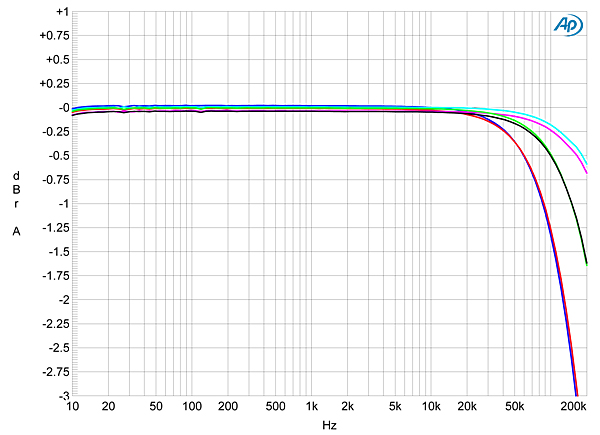
Fig.1 Ayre K-5xeMP, balanced frequency response at 1V into 100k ohms with volume control at "66" (left channel cyan, right magenta), "56" (left blue, right red), and "46" (left green, right gray). (0.25dB/vertical div.)
Channel separation (not shown) was superb, at >120dB in both directions below 2kHz. Noise was also very low: the unweighted, wideband signal/noise ratio ref. 1V output, taken with the volume control at its maximum but the input shorted, measured 80dB. Restricting the measurement bandwidth to 22Hz–22kHz increased the S/N ratio to 93.5dB, and switching in an A-weighting filter increased it further, to a superb 96.5dB.
Fig.2 plots the THD+noise percentage in the balanced output driving 100k ohms (right trace) and 600 ohms (left). The downward slope of the traces below 600mV (600 ohms) and 2V (100k ohms) means that the measurement is dominated by noise at these levels. The K-5xeMP clips at 22V, which is well above any voltage the preamp will be asked to deliver. The gradual rise in actual THD above 2V into 100k ohms is due to the absence of loop negative feedback, but as 2V is going to be around the maximum level the preamplifier will ever be asked to deliver, this suggests that the Ayre's gain architecture is well sorted, as they say in the country of my birth.
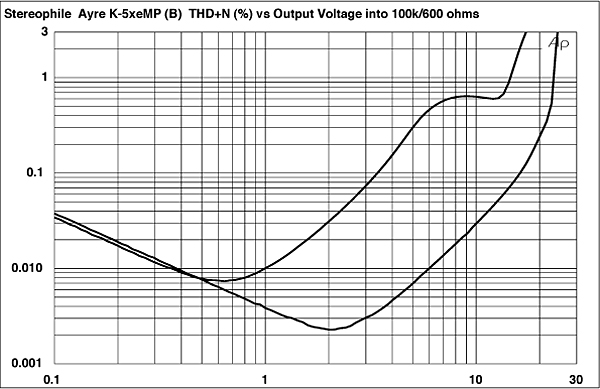
Fig.2 Ayre K-5xeMP, balanced distortion (%)vs 1kHz output voltage into (from right to left at 1% THD): 100k, 600 ohms.
The lack of feedback means that the THD starts to rise at a lower level into the demanding 600 ohm load, but is still a low 0.03% at 2V output. I wasn't able to test the THD+N against voltage performance for unbalanced operation. The preamp appears to clip just above 8V, which is less than half the balanced overload voltage. With the lower gain available in this mode, it appears that I was overloading the Ayre's FET switches rather than looking at actual output-stage clipping. Ayre specifies the maximum input level for unbalanced inputs as 4V RMS, which, with the 3.8dB maximum gain available, is 6.2V RMS at the output. However, this input level is still more than enough to handle the unbalanced outputs of even the hottest CD players and digital processors.
Because the K-5xeMP's THD+N measurement was dominated by noise below 2V, I measured the way in which the percentage changed with frequency at 3V, to be sure that the measurement was showing actual distortion. Even so, the THD+N percentage into 100k ohms (fig.3, blue and red traces) was very low at all frequencies. As expected, changing the load to 600 ohms increased the distortion. However, it looks as if the very low distortion is maintained into loads as low as 3k ohms, meaning that the K-5xeMP is basically bombproof.
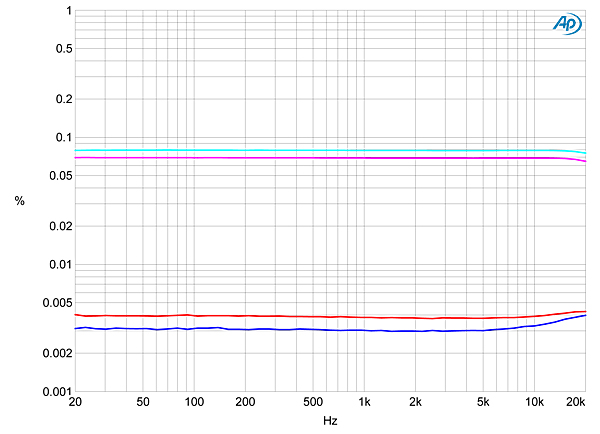
Fig.3 Ayre K-5xeMP, balanced THD+N (%)vs frequency at 3V into 100k ohms (left channel blue, right red) and 600 ohms (left cyan, right magenta).
As well as the distortion being very low in level, its harmonic spectrum consists entirely of the subjectively innocuous second and third harmonics (fig.4). This graph also shows some power-supply–related spuriae, but as these are all below –110dB, they are irrelevant to sound quality. Dropping the load to 600 ohms raises the level of these harmonics, especially in the left channel (fig.5, blue trace). The third harmonic is now the highest in level, at –70dB (0.03%), and the fourth and fifth harmonics now appear. Despite the absence of loop negative feedback, intermodulation distortion is also very low in level (fig.6).
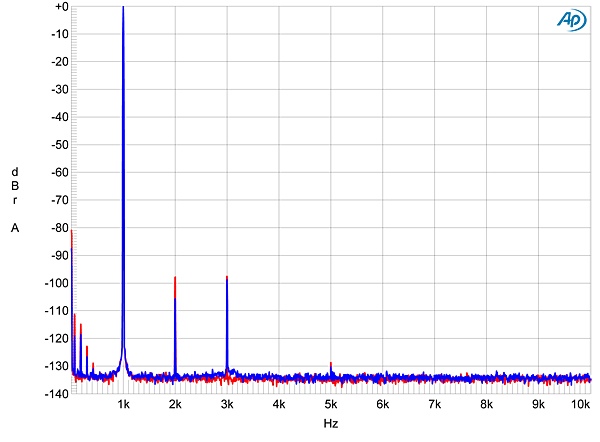
Fig.4 Ayre K-5xeMP, balanced spectrum of 1kHz sinewave, DC–10kHz, at 2V into 100k ohms (left channel blue, right red; linear frequency scale).
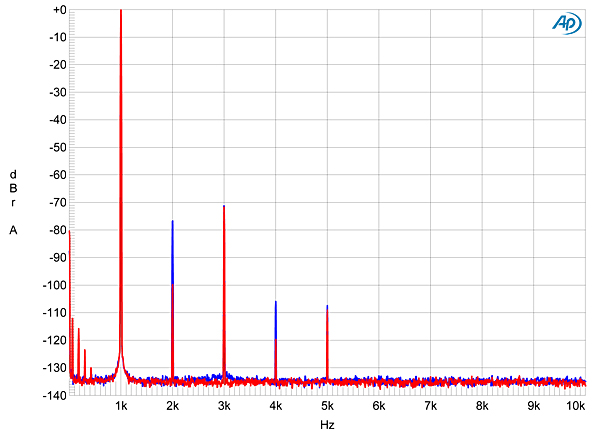
Fig.5 Ayre K-5xeMP, balanced spectrum of 1kHz sinewave, DC–10kHz, at 2V into 600 ohms (left channel blue, right red; linear frequency scale).
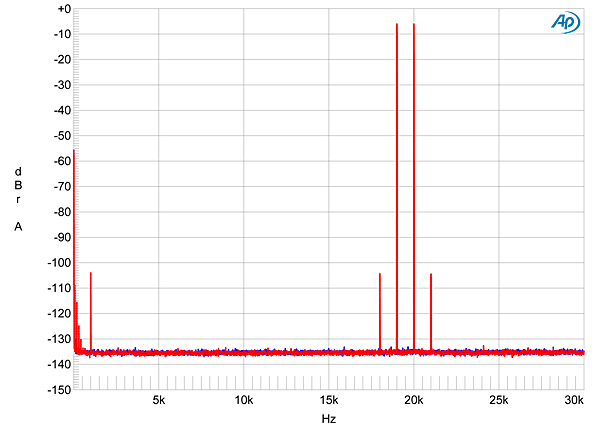
Fig.6 Ayre K-5xeMP, balanced HF intermodulation spectrum, DC–30kHz, 19+20kHz at 2V into 100k ohms (left channel blue, right red; linear frequency scale).
The Ayre K-5xeMP's measured performance is about as good as it gets for a solid-state preamplifier. That it achieves this without any loop negative feedback is a notable achievement.—John Atkinson
- Log in or register to post comments




































